Can the “Axis of Crude Oil” Topple the US Dollar?
Currencies / US Dollar May 01, 2007 - 05:05 PM GMTBy: Gary_Dorsch
Were it not for its “reserve currency” status, slowly turning into a post-World War II relic, the US dollar would have already collapsed by now. A string of $4.4 trillion of US trade deficits since 1996, and a heavy reliance on foreign money to fund its external imbalance, has severely weakened America's global economic leadership over the past five years.
The US dollar survives, due to America's political stability, its military might in the Persian Gulf, its large $12.5 trillion economy (28% of global GDP), and deep and liquid financial markets for bonds and stocks.
Last week, the US dollar fell to an all-time low against the Euro, a new milestone in a steep decline that began more than six years ago. The Euro hit a record high of $1.3682 on April 27th, up from $1.20 a year ago and as little as 83 cents in October 2000, when the rally against the dollar began. The British pound is hovering near $2 area, and the Australian dollar fetches 82.50 US-cents, both at 15-year highs.
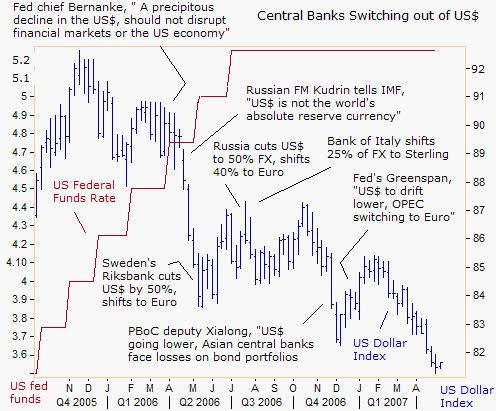
Since the beginning of the year, 50 of the world's currencies have risen against the dollar while only eight have declined. Behind the falling US dollar is a changing global economy. China and the US are the locomotives in the global economy, accounting for 60% of all the global growth in the last five years. But now, the $12.5 trillion US economy is sputtering, due to a slumping housing sector, while the $2.5 trillion Chinese economy is overheating, expanding at a blistering 11.1% pace in Q'1
India's elephant, China's dragon, and other dynamic economies, such as Russia and South Korea are expected to contribute more than 50% to world economic growth in 2007, with China's contribution alone being 30% and India's 10%. In comparison, the US contribution to world growth is expected to fall to 12%, after its economic output halved to 1.3% in Q'1, the smallest gain in four years.
Every time US year-on-year GDP growth has dipped below 2% since 1960, a full-blown recession unfolded. In contrast, the Euro zone economy is expanding at a 2.6% clip, its best performance in six years, and the European Central Bank is aiming to lift its interest rate in June, thus making the US dollar less attractive next to the Euro. As such, many foreign central banks have been reducing their exposure from the US dollar to the Euro and British pound over the past year.
US Dollar Slides despite Improvement in Foreign Trade
Since the bursting of the dot-com investment boom on Wall Street in 2001, the US Dollar Index has been sliding on a slippery slope, weakened by rising US trade and budget deficits, and an increasingly unpopular war in Iraq, which is costing the US Treasury about $2 billion per week. The US Dollar Index has a weighting of 57.6% in Euros, 13.6% in Japanese yen, 12% in British pounds, 9% in Canadian dollars, 4.2% in Swedish kronas, and 3.6% in Swiss francs.
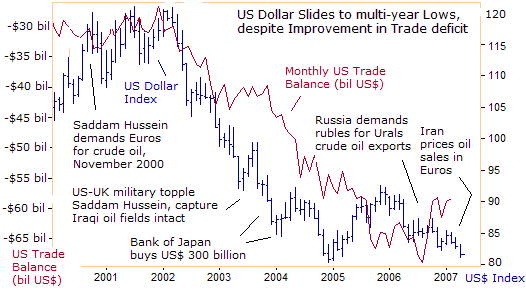
The weaker dollar is beginning to translate into an improved US trade balance for the first time in six years. The US trade deficit is February was $59.4 billion, compared with a record high of $69.6 billion in July 2006. In February, the US posted a surplus with Britain for the first time since 2001. For the first two months of 2007, the deficit with the European Union was less than $13 billion, down 28% from a year earlier. With Canada, the deficit fell to below $12 billion from more than $16 billion.
Still, the US deficit with China soared to a record high of $232.5 billion dollars in 2006, up from $201.5 billion the year before, to account for nearly one-third of the total. The annual US deficit with Japan also hit a new high at $88.4 billion, up 7.2% from 2005, thanks to Tokyo's weak yen policy. Beijing and Tokyo have achieved such spectacular results by manipulating their currencies against the US dollar.
Japanese Financial Warlords Buck the Trend
The giant US trade deficit of $763 billion in 2006 produced a huge outflow of dollars to other countries. The People's Bank of China, the Bank of Japan, and Arab Oil kingdoms have been the key linchpins in limiting the US dollar's losses by buying US Treasury debt. Foreign central banks boosted their holdings of US Treasury and agency debt by $14.2 billion in the week ended April 25th, to a record $1.93 trillion.
Although the US dollar is sliding to multi-year lows against most major currencies, the greenback is up 5% against the Japanese yen from a year ago. The Bank of Japan is the largest holder of US Treasures with $618 billion, and pursues a radical monetary policy, pegging its overnight loan rate at only half-percent, or 475 basis points below the US fed funds rate, in order to prop-up the US dollar.
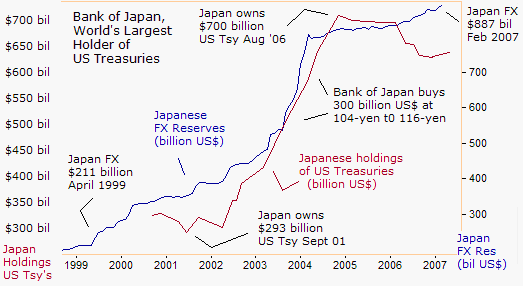
“Most countries are diversifying their investments to non-US dollar assets. But in the case of Japan, we are still cautious about shifting from the dollar to other currencies,” said Hiroshi Watanabe, Japan's powerful FX chief in Abu Dhabi, on April 19th “If we do that, it goes towards the depreciation of the dollar. So why should we trigger such a stupid action?” Watanabe asked.
The Bank of Japan is the world's largest “yen carry” trader. Last fiscal year, Tokyo paid 7.6 billion yen in interest expense, while earning 3 trillion yen in interest rate income on US Treasuries. “Thus, we don't have any plans to sell foreign currencies to redeem government bonds,” said Japanese finance minister Koji Omi on March 23rd.
The US Treasury is thrilled with Japan's “cheap yen” policy, which encourages the flow of capital from Tokyo to US financial markets. Tokyo also reaps big rewards, as yen has fallen 14% in the past year against the Euro, 5% against the dollar and 9% against China's yuan. That's boosted Japan's trade surplus by 74% to a record 1.63 trillion yen ($14 billion) in March from a year earlier. China overtook the US as Japan's largest trade partner in the year ended March 31st.
Arab Oil Kingdoms Recycle Petrodollars into US$
Washington's allies in the Arab world, particularly in the Persian Gulf, are now worried about the influence of Shi'ite Iran in Iraq and elsewhere in the predominantly Sunni Muslim region. The US accuses Tehran of seeking to set up a covert nuclear weapons program, a fear shared by Saudi Arabia, the world's biggest oil exporter. Riyadh fears that US troops will leave Iraq prematurely, and enable Iran to consolidate its influence and leaving Sunni Arabs at the mercy of Shi'ite militias.
The Arab Oil kingdoms are supporting the US war effort in Iraq by recycling much of their petrodollar surpluses into US Treasuries. But nearly four years into the Iraq war, America's patience with the war is growing thin. Democrats voted for a $124 billion funding bill for Afghanistan and Iraq for the current fiscal year, but with strings attached, ordering US troops to begin withdrawing from Iraq by October 1st.
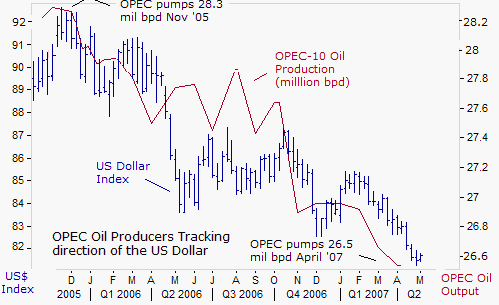
The Arab Oil kingdoms are willing to recycle petrodollars into US Treasuries, but also want to be compensated for a weaker dollar with higher oil prices. The OPEC-10 cartel has lowered its daily oil output by 1.8 million barrels since November 2005, and with the depletion of 500,000 bpd from Mexico's giant Cantarell oil field last year, OPEC is back in the driver's seat. OPEC has guided the benchmark North Sea Brent price upward to $68 /barrel, from as low as $51 /bl in January.
China Grows weary of weaker dollar, US Protectionist Threats
But while Tokyo's financial warlords and Arab Oil Kingdoms are firmly committed to the defense of the US dollar, how Beijing decides to use its $1.2 trillion of wealth would have much bigger ramifications for financial and commodities markets worldwide. China's FX reserves soared by $136 billion in Q'1, more than half the $247 billion gain for all of 2006, and are on course to reach $1.5 trillion next year.
China suffers losses on its massive $700 billion US bond portfolio, whenever it allows the dollar to move lower against the yuan. The dollar has fallen only 1.3% against the yuan so far this year, and dealers expect a devaluation of only 4% for 2007. Still, the dollar fell to a new post revaluation low of 7.7025 on April 30th, after the Chinese central bank raised bank reserve requirements 0.5% to 11% last Friday.

The slow pace of yuan appreciation could invite “veto-proof” US Congressional protectionist legislation against Chinese exports in the second half of this year. Until now, Congressional efforts to get China to move toward a more flexible exchange rate with threats of tariffs have been frustrated by the leverage exerted by the Chinese through their huge ownership of US Treasury debt.
But if the US Congress slaps tariffs on Chinese imports into the US this year, it might cause Beijing to switch its allegiance to the “Axis of Oil,” a loosely aligned alliance of top oil producers, who are slowly chipping away at the US dollar's allure, and aim to thwart American economic and foreign policy at every turn.
“Axis of Oil” Chipping away at US Dollar's Base of Support
The “Axis of Oil” led by Russia, Iran, and Venezuela, is slowly chipping away at the US dollar's status as the world's “reserve currency.” Russia, the world's second largest oil exporter demands rubles in exchange for its Urals crude oil, and Iran, the world's fourth largest oil exporter is earning most of its revenues in the Euro. Venezuela's central bank began shifting its FX reserves to Euros in 2005.
The “Axis of Oil” seeks to draw China into its sphere, exploiting China's huge thirst for oil. Iran became China's top oil supplier in January, providing 2.14 million tons of crude, up 13% over the same month last year, and tripling that of December's supply of 740,000 tons. China aims to establish 625 million barrels of strategic petroleum reserves to be able to cover 90 days of net oil imports by 2015.
China's state-run Zhuhai Zhenrong, the biggest buyer of Iranian crude worldwide, began paying for its oil in Euros late last year. Japanese refiners who buy 500,000 bpd of Iranian crude, or a fifth of Iran's 2.4 million-bpd shipments, continue to pay in dollars but are willing to shift to yen if asked.
A major share of global trade in commodities belongs to crude oil, which is widely transacted in US dollars. That forces oil importers and central banks to buy US dollars, regardless of the direction of US interest rates. Last month, world-wide oil consumption rose to 85.5 million bpd. By 2030, crude oil demand is expected to reach 118 million bpd, so the dollar-crude oil link is vital to maintain the dollar's “reserve currency” status, and allowing America to live beyond its means.
Right now, the only serious threat to the US dollar's international dominance is the Euro. The gross domestic product of the Euro zone is roughly the same as that of the US, and its population is 60% bigger. Europe is the Middle East's biggest trading partner, is a major oil importer, has a comparable share of global trade as the US, but its external accounts are much better balanced. The Euro zone ran a current account deficit of only 3.2 billion euros ($4.2 billion) over the past 12-months.
But the “Axis of Oil” could topple the US dollar, if it demands payment for oil sales in Euros. In November 2000, Saddam Hussein insisted that Iraq's oil be paid for in Euros. When the value of the Euro rose, Iraq's oil revenues increased accordingly. The economic threat this represented to the US dollar might have been one of the reasons why the Bush administration was so anxious to topple Saddam.
Russian Bear Leads the Assault on the US Dollar
But a greater threat to the US dollar's hegemony is the “Axis of Oil.” Russia is the #1 producer of natural gas and the #2 producer of crude oil and much of its vast energy assets are still under exploration. Each up-tick in the oil price pumps billions of additional dollars into the Kremlin's coffers. One year ago, on May 10th, Russian kingpin Vladimir Putin declared that Russian Urals blend crude oil would be traded for Russian rubles, instead of US dollars, and made the ruble fully convertible.
One month later, on June 8th, 2006, the Russian central bank said it had cut the share of US dollars in its reserves by 5% to 50% and boosted the Euro's share to 40%, with the rest in sterling and yen. Due to soaring oil revenues and an appreciating Euro, Russia's foreign exchange reserves have mushroomed to $361 billion today, the third largest in the world, behind China and Japan.
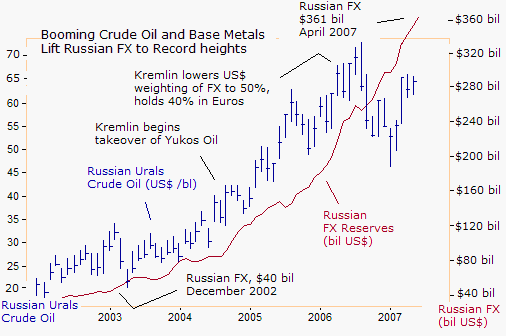
Russia's FX reserves now exceed its outstanding foreign debt of $103 billion, a vast improvement since 1998, when Moscow defaulted on $40 billion of debt repayments. Russia's FX reserves ballooned with a widening foreign trade surplus, which rose to $164.4 billion in 2006, up 15.1% from 2005. Two thirds of Russia's oil and natural gas exports were shipped to the European Union.
Russia's $800 billion economy expanded at a sizzling 8.4% rate in the first quarter, and industrial production was 16% higher from a year ago, outpaced only by China and India. The Kremlin is securing its control over Russia's natural resources, yet has done little to scare foreign investors away, at least in the energy sphere.
Russia attracted $26 billion in foreign direct investment last year, even after the Kremlin pressured Royal Dutch Shell to relinquish its controlling stake in the Sakhalin II oil-and-gas field, and installed Gazprom as the controlling partner. The Kremlin built Rosneft into the world leader among publicly traded oil companies with 16-billion barrels of oil reserves and 24.7 trillion cubic feet of natural gas, and a reserve life of 30-years for oil and 51-years for gas. Russia's other top oil producer Lukoil has oil and gas reserves of 20.4 billion barrels of oil equivalent.
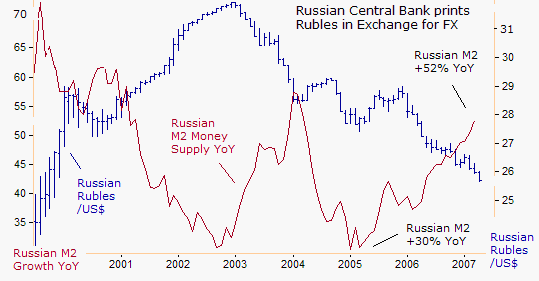
Russia also earns 15% of its export revenues from metals and is home to the world's largest nickel producer, Norilsk Nickel, and Rusal, the world's largest aluminum company. Russia is the world's fourth-largest steel maker with foreign sales of $22.5 billion and non-ferrous metal exports of $16.5 billion last year. Russia's gold mines produced 164.2 tons of the yellow metal last year.
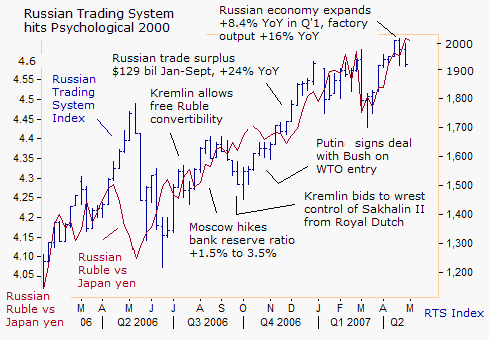
The Russian central bank prints massive amounts of rubles each year, in exchange for Euros and US dollars that are flooding into the country. The central bank said its M2 money supply grew by 52.7% in the 12-months thru April 1st. Yet the US dollar is sliding to seven year lows against the Russian ruble. The Russian central bank said the annual increase in Russian M2 is equal to around 27% of gross domestic product, which creates excessive liquidity and inflates financial assets. The Russian Trading System Index (RTS) has been further inflated by “yen carry” traders, who borrow yen in Tokyo at less than 1% to buy Russian stocks.
Russian kingpin Putin on Collision Course with US, Turns to China
Russia is the largest economy in the world that is not yet a member of the World Trade organization, and had apparently overcome all major roadblocks in bilateral WTO talks with the US last year. But once Putin made it clear that Russia would continue building Iran's nuclear reactor, the US began hindering its admission to the global trade body. On April 9th, US Trade Representatives Susan Schwab said Moscow was making only “slow progress for entry into the world trade body.”
“We would like to see Russia a full fledged member of the WTO and hope that Russia will undertake the commitments and responsibilities, the obligations that come with being a WTO member,” she said. Schwab also said Congress was not prepared to revoke the 1974 Jackson-Vanik amendment, crucial for Moscow to enter the WTO.
On April 23rd, US Defense chief Robert Gates met with Putin to address criticism of Washington's plans to place missile defense systems in Poland and the Czech Republic, a dispute that is driving relations between the countries to a Cold War low. Putin argues the sites are too close to Russia's borders and the US could eventually equip the sites with offensive weapons aimed at But in a swipe at Russia's steadfast support for the Iranian regime, Washington says its 10 interceptor missile sites in Poland and radar in the Czech Republic are meant to defend against long-range missile threats from Iran.
Washington also accuses Moscow of rolling back democracy and reviving its imperialist past, and Moscow charges Washington with meddling in its domestic affairs.
America's efforts to isolate Iran diplomatically and economically have been frustrated by Putin's insuring that any UN Security Council resolutions against Tehran's mullahs are watered down as much as possible. Russia.
Two days later, on April 28th, Russia's pipeline monopoly Transneft said it has built a third of its planned pipeline to China and is on track to complete the 1650 mile pipeline by the end of 2008. The pipeline, Russia's first oil route to Asia, will eventually pump 600,000 barrels per day of crude oil to China. |

China is a major buyer of Russia's oil and natural gas and lobbied hard for top priority access over Japan to the oil pipeline carrying Siberian crude to Asian markets. China is also helping Russia develop its natural resources, particularly in Siberia. Trading between the two emerging giants is growing rapidly.
In February 2005, Russian Finance chief Kudrin revealed that Chinese banks provided $6 billion in financing for Rosneft's acquisition of Yuganskneftegaz, secured by long-term oil delivery contracts between Rosneft and the Chinese National Petroleum Company. The CNPC is also involved in several joint ventures with Gazprom to develop energy reserves in Iran.
Last year, bilateral Sino-Russian trade was $33 billion, up from $20 billion in 2005, and is expected to reach $70 billion by 2010. China is Russia's fourth largest trading partner while Russia is China's eighth largest trading partner. They are the most important members of the Shanghai Cooperation Council, one of the most powerful economic centers of the world.
Iran Solidifies Alliance with China
Beijing must walk along a delicate tightrope, balancing its hugely profitable trade surplus of $232 billion with the United States, against its increasing dependence on crude oil imports from Iran. An oil exporter until 1993, China now produces only for domestic use. Its proven oil reserves at home could be depleted in 12 years, so Beijing is aggressively trying to secure supplies in hot spots the globe.
China's Sinopec 0386.hk will visit Iran next week to discuss outstanding financial issues on a possible $100 billion deal to develop the giant Yadavaran oilfield said Gholamhossein Nozari, director of the National Iranian Oil Company. Yadavaran is expected to produce 300,000 bpd, about the same amount Iran now exports to China. Royal Dutch Shell is also interested in participating in Yadavaran.
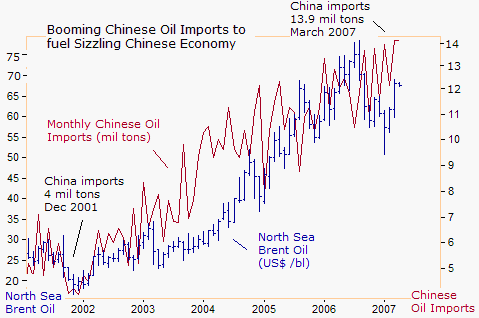
Beijing also wants to reinforce its relations with Iran to tap the Caspian Sea energy region, and lessen its dependence on maritime oil imports from the Arab kingdoms in the Persian Gulf, thus securing an uninterrupted flow of oil. China proposes to help Iran modernize its petroleum industry and the wider Iranian economy with industrial technology, capital, engineering services and nuclear technology.
The Sino-Iranian economic relationship extends beyond exploitation of Iran's oil reserves. Beijing sells anti-ship missiles like the Silkworm and surface-to-surface cruise missiles to Tehran, and has assisted in the development of Iran's long-range ballistic Shihab-3 and Shihab-4 missiles. But Beijing wants to deepen the presence of its firms in the Iranian market, which could be a good outlet for Chinese exports.
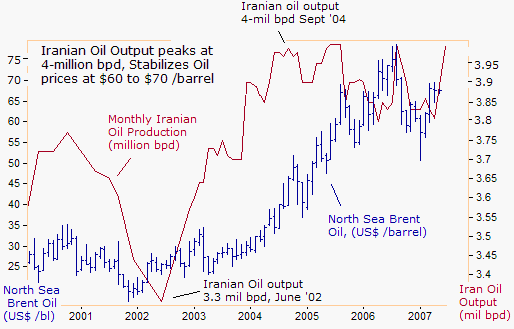
Blessed with the second largest oil reserves in the world, Iran's oil production has averaged about 3.9 million for the past three years. However, as a result of surging domestic demand, growing 10% per year and depleting oil fields, Iranian oil and gas revenues are expected to fall from $54 billion in 2006 to $49 billion this year. In ten years, Iran's 2.4 million bpd of oil exports could dry up, unless new oil fields are developed with the help of Chinese, Russian, or European oil companies.
But the US State Department is strongly urging its trading partners not to invest in Iran. The US Congress is pushing a broad spectrum of legislation against Iran this year, with “veto proof” bipartisan support. The most recent proposal is sponsored by Senator Chris Dodd and Rep Tom Lantos, which brings China and Russia into the fray, threatening economic sanctions on any country that aids Iran's oil industry.
But Tehran is well aware of its commercial links with other nations, and buys one third of its imports from the European Union, led by Germany, France, and Italy. This all means that Iran is actually in a far stronger position than its size. Consider the year of debating, cajoling, threatening, and blackmailing that went into two UN Security Council resolutions aimed at Iran's nuclear program. In the end, China and Russia stripped the guts outs of the resolutions.
Meanwhile, tension with Iran over its nuclear weapons drive is keeping oil prices high, which in turn, pumps up the flow of cash to the Kremlin and Venezuela. For good measure, Iran sits on the neck of the Strait of Hormuz, through which 17-million barrels of oil flows each day. Once Iran's mullahs obtain nuclear weapons, the cost of crude oil and shipping rates could sky rocket, and force central banks to inflate their money supplies at an even faster clip, to offset the economic pain.
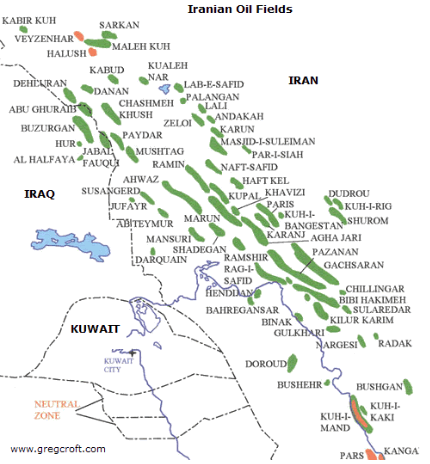
On March 26th, Ebrahim Sheibany, Iran's central banker said the Iranian economy can withstand the watered down UN sanctions, and the regime has enough foreign currency reserves to handle any major shocks. “In US dollars, it is at 20% because we need to keep that” he said. Sheibany indicated that Iran is asking overseas buyers of its oil, including China, to pay in Euros rather than US dollars, a tactic that is being closely watched by foreign-exchange markets.
“That's our policy and right now we are doing that. I think that this is bad for America and the importers. As I say, I believe that they are shooting their own foot because they have international currency and they should take care of that. If not, we are shifting to other currencies,” Sheibany said.
Venezuela's Hugo Chavez a key player in the “Axis of Oil”
Adding Venezuela's mercurial Hugo Chavez to the “Axis of Oil”, makes matters much tougher for Washington. Venezuela is the fourth-largest supplier of oil to the United States, accounting for more than 10% of American oil imports, and ships 1.3 million barrels of crude oil north every day. Chavez has promised to cut off oil shipments to the US, if Iran is attacked by the US military. Chavez has already reduced oil shipments to the US by 200,000 bpd from a year ago.
 On July 30th, 2006, on a two day visit to Tehran, Chavez pledged that his country would “stay by Iran at any time and under any condition. We are with you and with Iran forever. As long as we remain united we will be able to defeat US imperialism, but if we are divided they will push us aside,” Chavez said. He invited Iranian oil companies to invest in Venezuela.
On July 30th, 2006, on a two day visit to Tehran, Chavez pledged that his country would “stay by Iran at any time and under any condition. We are with you and with Iran forever. As long as we remain united we will be able to defeat US imperialism, but if we are divided they will push us aside,” Chavez said. He invited Iranian oil companies to invest in Venezuela.
Iran's president, Mahmoud Ahmedinejad, replied, “I feel I have met a brother and trench mate after meeting Chavez. We do not have any limitation in cooperation. Iran and Venezuela are next to each other and supporters of each other. Chavez is a source of a progressive and revolutionary current in South America and his stance in restricting imperialism is tangible.”
Chavez noted that, “Russia helped break a US-imposed blockade by agreeing to sell fighter planes and helicopters worth billions of dollars to Venezuela.”
On May 1st, Chavez declared that Venezuela will strip the world's biggest oil companies of operational control over the Orinoco Belt crude projects that can convert about 600,000 bpd of heavy, tar like crude into valuable synthetic oil. Oil Minister Rafael Ramirez has said that Venezuela will only consider agreements on the booked value of the projects rather than their much larger current net worth.
Venezuela says there are around 235 billion barrels of crude reserves in the vast Orinoco Belt, and if correct, would give Chavez the planet's largest oil supply. Venezuela currently has 80 billion barrels of proven reserves. Petroleos de Venezuela PDVSA is working with oil companies from China, India, Iran and Brazil to certify the Orinoco reserves, while Chavez seeks to reduce his reliance on the United States.
The implications are potentially stark for the United States, which imports 62% of its oil supply. Chavez says PDVSA is ready to become the sole energy supplier to Cuba, Bolivia, Nicaragua and Haiti, and would finance up to 50% of the total oil bill. Chavez is also giving away at least 100,000 bpd to Cuba, which the Castro brothers sell on the open market at their own profit, draining Venezuela's finances further.
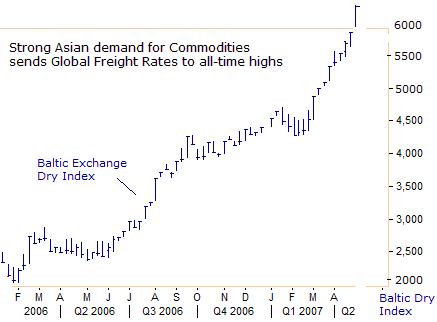
Chavez is absorbing higher shipping costs to reach China, expanding oil exports to the Asian juggernaut by tenfold, to about 160,000 bpd since 2004. The Baltic Exchange's Dry Freight Index, a composite of global seaborne trade routes for commodities, hit a record high on April 27th, driven by surging demand for raw materials to Asia. The cost index of merchant ships, tripled to 6,230 points over the past 14-months, surpassing the all-time high of 6,208 in Dec 2004.
Venezuelan Finance Minister Nelson Merentes said Caracas used some petrodollars to pay off $4.7 billion of foreign debt in 2006, lowering the national debt by 15% to $26.3 billion. Merentes aims for Venezuela's debt to be lower than 25% of Gross Domestic Product by the end of 2008. Revenue at PDVSA came to $101 billion in 2006, but the net profit was only $4.8 billion. Chavez spent an estimated $9 billion to keep gasoline prices under 20 cents a gallon, and spent billions more to cement political alliances with Bolivia, Cuba, and Nicaragua.

Still, Chávez could poses a much bigger threat to America's energy security than Saddam Hussein ever did. Last week, Rafael Ramírez, Venezuela's energy minister, sent a chilling signal that Caracas might sell refineries in Texas and Louisiana that process crude from Exxon's Venezuelan oil fields. Chavez could be setting the stage to export much less crude oil to the United States in the future.
The G-7 Response to an “Axis of Oil” Shift from the US Dollar
During the last several decades, control of global oil reserves has steadily passed from private companies to national oil companies like Rosneft and Petróleos de Venezuela. Roughly 77% of the world's 1.15 trillion barrels of proven reserves is in the hands of the national companies, and 14 of the top-20 oil companies are state-controlled. Together, the “Axis of Oil” pumps one-fifth of global oil output.
Maintaining the US dollar monopoly on the sale of oil is critical to the Fed's ability to print money, without sending the greenback into a tailspin. However, if the ”Axis of Oil” and /or the Chinese dragon decide to shift more of their trade surpluses towards the Euro or gold, it could seriously undermine the US dollar, increasing the cost of US imports, and corral the US economy into the “Stagflation” trap.
Such a scenario is more likely in the event of a US military strike on Iran. But the Group of Seven central banks have worked together for a long time, dealing with many market crises, usually by coordinated inflation of their money supplies, to keep currencies in stable target zones. Still, a shift by the “Axis of Oil” and especially China, away from the US dollar could override the G-7's manipulative antics.
On May 1st, Fed chief Ben Bernanke warned Congress against imposing tariffs on Chinese imports into the US, which could spark Beijing's flight from the dollar. “If trade both destroys and creates jobs, what is its overall effect on employment? The answer is, essentially, none,” Bernanke said in Butte, Montana. The Fed's ability to print unlimited amounts of US dollars and inflate assets, might hang in the balance.
This article is just the "Tip of the Iceberg", of what's available in the Global Money Trends newsletter, published on Friday mornings, for 44 issues per year !
By Gary Dorsch,
Editor, Global Money Trends newsletter
Here's what you will receive with a subscription,
Insightful analysis and predictions for the (1) top dozen stock markets around the world, Exchange Traded Funds, and US home-builder indexes (2) Commodities such as crude oil, copper, gold, silver, the DJ Commodity Index, and gold mining and oil company indexes (3) Foreign currencies such as, the Australian dollar, British pound, Euro, Japanese yen, and Canadian dollar (4) Libor interest rates, global bond markets and central bank monetary policies, (5) Central banker "Jawboning" and Intervention techniques that move markets.
GMT filters important news and information into (1) bullet-point, easy to understand analysis, (2) featuring "Inter-Market Technical Analysis" that visually displays the dynamic inter-relationships between foreign currencies, commodities, interest rates and the stock markets from a dozen key countries around the world. Also included are (3) charts of key economic statistics of foreign countries that move markets.
A subscription to Global Money Trends is offered at only $140 US dollars per year for “44 weekly issues”, including access to all back issues. Click on the following hyperlink, to order now, http://www.sirchartsalot.com/newsletters.php Call toll free from USA to order, Sunday thru Thursday, 2 am to 4 pm EST, at 866-576-7872.
Mr Dorsch worked on the trading floor of the Chicago Mercantile Exchange for nine years as the chief Financial Futures Analyst for three clearing firms, Oppenheimer Rouse Futures Inc, GH Miller and Company, and a commodity fund at the LNS Financial Group.
As a transactional broker for Charles Schwab's Global Investment Services department, Mr Dorsch handled thousands of customer trades in 45 stock exchanges around the world, including Australia, Canada, Japan, Hong Kong, the Euro zone, London, Toronto, South Africa, Mexico, and New Zealand, and Canadian oil trusts, ADR's and Exchange Traded Funds.
He wrote a weekly newsletter from 2000 thru September 2005 called, "Foreign Currency Trends" for Charles Schwab's Global Investment department, featuring inter-market technical analysis, to understand the dynamic inter-relationships between the foreign exchange, global bond and stock markets, and key industrial commodities.
Copyright © 2005-2007 SirChartsAlot, Inc. All rights reserved.
Disclaimer: SirChartsAlot.com's analysis and insights are based upon data gathered by it from various sources believed to be reliable, complete and accurate. However, no guarantee is made by SirChartsAlot.com as to the reliability, completeness and accuracy of the data so analyzed. SirChartsAlot.com is in the business of gathering information, analyzing it and disseminating the analysis for informational and educational purposes only. SirChartsAlot.com attempts to analyze trends, not make recommendations. All statements and expressions are the opinion of SirChartsAlot.com and are not meant to be investment advice or solicitation or recommendation to establish market positions. Our opinions are subject to change without notice. SirChartsAlot.com strongly advises readers to conduct thorough research relevant to decisions and verify facts from various independent sources.
© 2005-2022 http://www.MarketOracle.co.uk - The Market Oracle is a FREE Daily Financial Markets Analysis & Forecasting online publication.
Comments
|
01 May 07, 22:05 |
Thats a big post dude ! |




 Moscow has also provided Iran with anti-aircraft missile systems and S-300 missiles that could make any possible US military strike on Iranian nuclear sites more dangerous. Then on April 26th, Russian kingpin Putin suspended Russia's obligations under the Conventional Forces in Europe Treaty, a move he linked to US plans for a missile defense shield in Europe.
Moscow has also provided Iran with anti-aircraft missile systems and S-300 missiles that could make any possible US military strike on Iranian nuclear sites more dangerous. Then on April 26th, Russian kingpin Putin suspended Russia's obligations under the Conventional Forces in Europe Treaty, a move he linked to US plans for a missile defense shield in Europe.